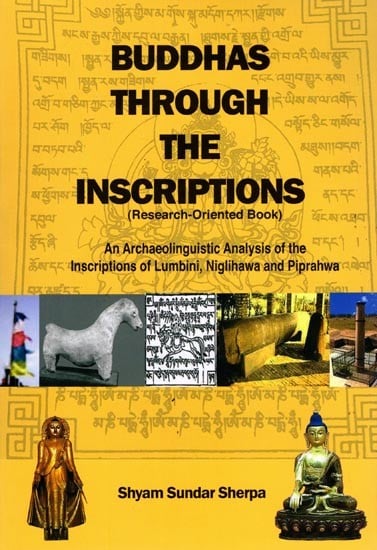
| Specifications |
| Publisher: KAMU SHERPA | |
| Author Shyam Sundar Sherpa | |
| Language: English | |
| Pages: 168 (Throughout B/w Illustrations) | |
| Cover: PAPERBACK | |
| 8x6 inch | |
| Weight 232 gm | |
| Edition: 2024 | |
| ISBN: 9789937163255 | |
| HBA771 |
| Delivery and Return Policies |
| Ships in 1-3 days | |
| Returns and Exchanges accepted within 7 days | |
| Free Delivery |
Result of lifetime' devotion BUDDHAS THROUGH THE INSCRIPTIONS is the 2nd first innovative landmark publication in this world. This study is an empirical and up-to-date archaeolinguistic study that includes the archaeolinguistic analysis and synthesis of the terms of the toponyms and inscriptions of Lumbini, Niglihawa and Piprahwa. The Sanskritized Sherpa words which are the corrupt forms of the polysynthetic Sherpa words including Lumbini, Nigalihaba and Pin-pharawa. Similarly, the Lumbini, Niglihawa and Piprahwa Inscriptions are written in Brahmi script using the words of Sanskrit, Pali, Prakrit and Sherpa languages, conforming that the inscriptions of Lumbini and Piprahwa are closely related to the life to death rites and rituals of Siddhartha Gautama Buddha, while the inscription of Niglihawa is closely related with the life to death rites and rituals of Kanakamuni Buddha, which exactly tally with those of the aboriginal Sherpas, proving that the Buddhas and Ashoka were the aboriginal Sherpas. Moreover, Lumbini inscription conforms that Ashoka had erected a stupa on the foundation of the Madevi Devi Temple, erecting the Ashokan pillar of Lumbini as the representation of the Sherpa religious flag called ksyo-ta which contains the image of a flying horse in the centre of the hymn, showing that the Lumbini pillar must have a stone horse on its top. Furthermore, the term bali of the Lumbini pillar inscription conveys the correct meaning of the sacrifice running from the Vedic time and suggests to cut off this custom of sacrifice to adopt the Eightfold Path of Buddhism for the respect'of Lord Buddha who was born in Lumbini, rejecting the views of some eminent scholars of this world who have wrongly translated the term bali of the inscription as tax to be paid to the government of the Indian empire of Ashoka. Eventually, the Piprahwa stupa inscription conforms that the Piprahwa stupa was erected by the Buddha's relatives according to the Sherpa tradition, believing that the Buddha belonged to the Sherpa tribe and not to the Shakya tribe which was not in existence in the days of yore before the enlightenment of the Shakyamuni Buddha.
This research work entitled Buddhas Through the Inscriptions (Research-Oriented Book) is the 4th innovative landmark study in the world. The research work in this field is still in its infancy. This work is primarily based on the author's previous research works, viz, Sindhu Tatha Nepali Sabhyata ra Sanskrtka Nirmata Serpa Adivsiharu (Sherpa Authors of Indus and Nepalese Civilizations and Cultures), Sindhu Tatha Nepali Sabhyata ra Sanskrıka Nirmataharu (Authors of Indus and Nepalese Civilizations and Cultures) and LINGUISTIC ARCHAEOLOGY OF INDUS AND NEPALESE CIVILIZATIONS (Research-Oriented Book). The former two books are written in Nepali language and the latter one written in English language. All these books are the world's first innovative landmark publications.
This research work is an empirical and up to date archaeolinguistic study of the terms of the toponyms and inscriptions of Lumbini, Niglihawa and Piprahwa. The toponyms of these places are made up of the Sanskritized Sherpa words which are the corrupt forms of the polysynthetic Sherpa terms including Lumbini, Nigalihaba and Pin-pharawa. Similarly, the inscriptions of Lumbini, Niglihawa and Piprahwa are written in Brahmi script using the words of Sanskrit, Pali, Prakrit and Sherpa languages. This analysis confirms that the inscriptions of Lumbini and Piprahwa are closely related to the life-to-death rites and rituals of Siddhartha Gautama Buddha, while the inscription of Niglihawa is closely related to the life-to-death rites and rituals of Kanakamuni Buddha. These life-to-death rites and rituals of the Buddhas exactly tally with those of the aboriginal Sherpas, proving that the Buddhas were the aboriginal Sherpas. Moreover, the Lumbini inscription conforms that the Mauryan Emperor Ashoka had erected a stupa on the foundation of the Maya Devi Temple, erecting the Ashokan pillar of Lumbini as the representation of the Sherpa religious flag.
Prof. Shyam Sundar Sherpa is hard working devoted person and wanted me to write few words on "Buddhas Through the Inscriptions". In this book he has mentioned about various places associated with Buddha such as Lumbini, Niglihawa, Piprahawa as well as emperor Ashoka's visit in these places. He has done research of the inscriptions found and explored the main outcomes in this book. Since it is based on inscriptions, it provides authentic evidences to the historians and those who are interested in Buddhist studies.
He has also mentioned that making of "Stupa" in their home existed since ancient times among Sherpas later others imitated them and began its construction has been explained in this book. Beside this, the author also has mentioned about the inscriptions with Brahmi script existed in these places. In his view, the inscriptions at Niglihawa, Lumbini and Piparhawa are in mixed languages such as Pali, Prakrit, Sherpa and Samskrit too. The book authenticates Buddha through inscriptions.
Send as free online greeting card

Visual Search